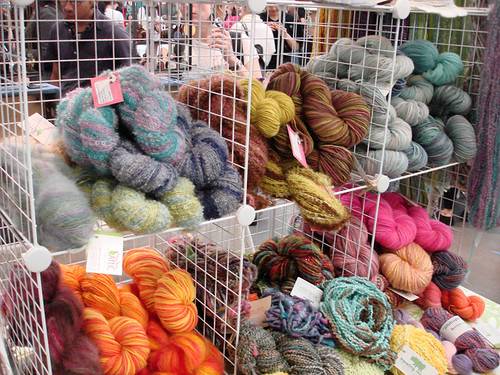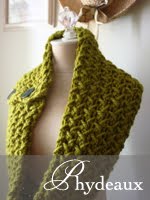 |
| { source } |
Many of my friends hate going to yarn shops because they can't understand the language. They aren't fluent in fiber speak. And sometimes the yarn shop staff are a little condescending, rather than helpful, in their communications.
For instance, yarn "weight" is a whole language unto itself.
Many shops organize their yarns by "weight." Many knitters, from casual to more experienced, are completely mystified by this whole weight thing.
Here's what you need to know about weights in a nutshell:
Yarn weight refers to the width or circumference of the fiber, as well as the yardage that exists within a standard weight (3.5 oz/100 gms is common).
Finer (skinnier) yarns will have more yardage per 4 oz. Bulkier (wider/chunkier) yarns will have less yardage per 4 oz.
Weights run from lightest (super fine lace) to heaviest (super bulky). Generally, the gradation of weight is as follows:
Super fine/cobweb lace
Fine lace
Lace
Light fingering/sock
Fingering/sock
Heavy fingering/sport
Sport
DK
Worsted
Aran
Chunky
Bulky
Super bulky/roving
So weight, related to the width of the yarn strand, can (and often is) be measured/determined by "wraps per inch" (WPI), which is measured by literally wrapping a yarn strand around a ruler to see how many times you can wrap that strand within one inch (p.s., this isn't very objective, given tension differences). Weight is also determined by a standard gauge (this is a whole different topic!), or stitches per four inch swatch, using a standard needle size. For instance, worsted weight yarn gauge is 16-20 stitches per four inches knit in stockinette using size 7 to 9 US needles.
Many shops arrange their yarns by weight. If you're knitting a lace shawl, you want finer weight yarns (lace to fingering). If you're knitting socks, you probably want sock (fingering) weight yarn.
Not all yarn manufacturers use the same weight terminology, but most use a standardized symbol system for yarn weight, which you can see on the Craft Yarn Council's website.
This is just a brief overview of yarn weight. Here are a few additional resources for you:
Craft Yarn Council Standard Yarn Weight System
Knit Finder References
Knit Picks Yarn Weights
What do you find most tricky or confusing about yarn weights? And which do you tend to knit with the most??



3 comments:
The trickiest yarn I worked w/was kid mohair for a laced cowl pattern. Man, I wanted to burn that yarn after awhile. It took me some time to get used to it, to be able to count my stitches and diagnose my mistakes.
I find fingering weight tricky to work w/b/c it's so thin and working w/the skinnier needles can make my hands ache. I tend to lean toward worsted weight yarn or maybe dk.
This post is quite helpful ... I know I will refer back to it often!
Stef, I think most knitters lean toward the middleweights! I tend to knit with the extremes (lighter weight and bulkier weight), both of which can be hard on my hands on fingers. I switch projects when that happens - less hand cramping! :)
Thank you, Vicki! :)
Post a Comment